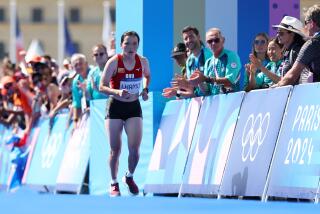Olympian Wins in the Long Run
- Share via
In a small red home guarded by six eucalyptus trees in the Tustin foothills, Anne Vrana O’Brien pushes her walker through a narrow hallway and into a room no larger than 10 feet square.
She shuffles around her walker and falls wearily into a soft armchair. “This,” O’Brien says, “is my Olympic room.”
There is a desk and a cabinet and bookshelves and a chest of drawers shoved together lining more than half the room. Every inch, it seems, is covered with Olympic and other competitive memorabilia, in piles, shoved into drawers, stacked on shelves, in small boxes.
O’Brien, at 89 among the U.S.’s oldest Olympians, hasn’t run a race in 64 years, and still she finds photos and newspaper clippings without wasting a step.
Her cheekbones are pronounced, and even though she is bent over the handles of the walker, it is evident she is lanky, just like in the old pictures, where she is wearing her track uniform, shorts daringly rolled to mid-thigh. She is nervous about her hair, which she says needs a trim. Her legs ache, in part from a recent fall in her kitchen.
Her Olympic journeys more than six decades ago remain fresh in her mind. O’Brien is a two-time Olympian, a sprinter from Los Angeles and then Orange County who found a way to compete in the 1928 and 1936 Games. She ran at the highest levels despite few athletic opportunities for women in the West. Her parents, Hungarian immigrants, sent their youngest daughter abroad only after weeks of pleading by Olympic officials.
In 1928, O’Brien turned 16 on the ship that took the U.S. Olympic team from New York to Amsterdam. Eight years later, she left a husband and daughter behind for weeks to run the hurdles in Berlin. In between, in the 1932 Games in Los Angeles, she was an alternate.
“I wanted to do those things and I felt like I could do them,” O’Brien says. “It gave me a bigger aspect on people. I realized that different people live different lives. It was very enlightening.”
O’Brien often chuckles at the stories as she recalls them, saying, “Women just didn’t do those things.”
Anne Vrana O’Brien did. She boarded trains and ships that took her to amazing places, and returned with stories of Jesse Owens and Paavo Nurmi and Babe Didrikson and Adolf Hitler.
Though she failed to medal in her events--she false-started twice and was disqualified in the 100-meter dash in Amsterdam and was eliminated before the 80-meter hurdle finals in Berlin--O’Brien doesn’t hint of disappointment. She seems to enjoy replaying her life, here in a room surrounded by ships and medals and photos of the athletic-looking girl in the page-boy haircut.
“I was very radical,” she says, grinning. “I’m still radical.”
O’Brien rises from her chair, accepting a steadying hand, and returns with a tiny yellowed rectangle of newsprint.
“You’ve heard of Babe Didrikson?” she asks, handing over the paper.
From The Times in 1932, the article reads, in part, “Babe Didrikson ran into some real opposition when her heat of the 100 came up, where she finished second to [Anne] O’Brien of Los Angeles. In a brilliant battle, Mrs. O’Brien, apparently fully recovered from a mishap in the hurdles, ran the distance in 12.5.”
“People,” she says, “don’t believe that.”
She laughs as if it doesn’t really matter. The meet was the pre-Olympic trials. Earlier in the day, O’Brien had stumbled in the hurdles and injured her legs on the track. After winning the 100-meter heat, she said, a doctor injected her with medication intended to prevent infection.
“It knocked me completely out,” she says, “so I didn’t get a chance to run the final race.”
O’Brien made the U.S. team as a hurdler in 1936. She witnessed Owens’ brilliance from a stadium seat just below Hitler’s. After watching from her dorm room window as Nazi troops marched quietly after midnight in the quad below, O’Brien became suspicious.
“I always felt there were some days Hitler didn’t look the same,” she says. “I think they had somebody who would take his place every once in a while, because he just wasn’t the same. Of course, we couldn’t take any pictures.
“The main thing was everything was regimented. Anyplace we went they had [a Nazi chaperon] with us. The big deal was trying to ditch them. We’d get together and two of us would go one way and two would go the other to get away. We couldn’t make a move without somebody being with us.”
O’Brien is mostly alone now. Her husband, Howard, an oil-field worker, died 16 years ago. Her daughter, Pat, lives in Wyoming. Her sister died two months ago, a hurt so raw she cannot bring herself to say her name.
After the stories, O’Brien sits on the front porch, cooled by a breeze through the eucalyptus trees and a clutch of birds of paradise that are about 10 feet high and 20 feet around. She rises from her plastic chair. “If you give me a hand, I’ll show you something,” she says.
Ten steps away, she opens a door that leads to a two-car garage that contains a vintage Cadillac that probably hasn’t been driven for a decade. She points to the top of a cabinet. “There is a pair of my old track shoes up there,” she says.
There are a bucket and some paintbrushes and a roller. But no shoes.
“Oh,” she says sadly. “I guess they’re gone.”
O’Brien then shrugs and smiles. The memories remain.
More to Read
Go beyond the scoreboard
Get the latest on L.A.'s teams in the daily Sports Report newsletter.
You may occasionally receive promotional content from the Los Angeles Times.






